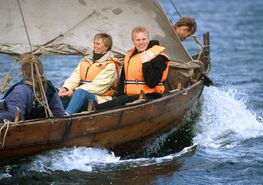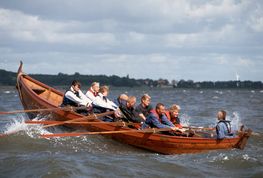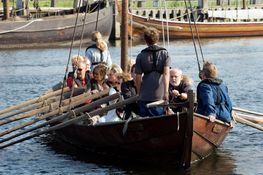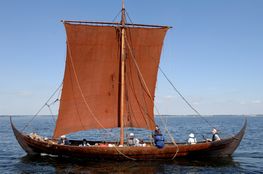Safety on board
You can safely step aboard the Viking Ship Museum's vessels. We have done everything necessary to ensure that the sailings are carried out in a safe and secure manner, so that the experience and joy of sailing is optimal for you as a passenger.
Below you can read the most important rules for all sailing with passengers in boats from the Viking Ship Museum's boat collection.
All sailings with passengers are conducted by boat captains approved by the Viking Ship Museum's sailing manager, who is responsible for ensuring that each sailing is carried out in accordance with the regulations below, maritime rules, and good seamanship.
The boat captain must hold either a special coastal navigation certificate for the specific boat or a coastal navigation certificate issued on the 'Competency Certificate for Merchant Ships' and be approved by the Viking Ship Museum's sailing manager based on an overall assessment of the boat captain's experience and familiarity with the specific type of boat. Additionally, the boat captain must possess a valid seafarer's medical certificate.
For safety reasons, the boat captain can always cancel or shorten a sailing based on a specific assessment of the boat, crew, passengers, and weather conditions. In such cases, the customer will not be required to pay for the trip or will receive the shortened trip at a reduced price.
When sailing with boats carrying more than eight passengers, one or more crew members must assist the boat captain in operating the ship. Crew members should possess knowledge and skills related to the specific type of boat.
During the voyage, a crew member may take command, but the sailing still occurs under the responsibility of the boat captain.
Rowing trips can be carried out with only one crew member.
In connection with courses, school camps or similar, the number of guests may be reduced to the minimum number. The boatmaster must ensure that the number of people on board is sufficient to complete the voyage safely.
Trolle, Krákan and Blakmand
Crew size: 1 (boat driver)
Max. on board, incl. crew: Normally 9 (approved for 10)
Trolle with square sail
Crew size: 2 (boatmaster and guest)
Max. on board, incl. crew: 10
Sulen and Storkjoven
Crew size: 2 (captain and guest)
Max. persons on board, incl. crew: 23
You sail in boats approved by the Danish Maritime Authority for passenger sailing and with a valid speed license.
The boats are equipped with rafts with space for everyone on board, as well as a pump, bailer, bucket and anchor with associated chain and anchor rope.
Before sailing, the boat captain ensures that the above equipment is in order and that the boat is rigged correctly.
Minor deficiencies are addressed on-site by the boat drivers and crew members present at work. Major damages and deficiencies are resolved by the museum's boatyard.
During navigation, the following items are on board the boat: nautical charts, compass, foghorn, flashlight, first aid kit, VHF radio, and an emergency signal kit containing parachute flares, handheld flares, and smoke signals.
A mobile phone is carried on all voyages for communication with the shore.
All voyages begin with an introduction to sailing and instructions on the use of life vests. Everyone, including the boat captain and crew members, wears a life vest throughout the entire journey.
Participants are involved to the greatest extent possible in rowing and handling the sails
[All voyages are recorded in the logbook, and upon the conclusion of the sailing, it is also logged out in the logbook
All voyages commence at the Boathouse on Tunet. A brief introduction to the sailing is provided here. Passengers are welcome to leave their luggage, but the museum does not take responsibility for any left belongings.
All payments for tourist cruises take place at the ticket office. For group tours and school trips, the administration will send an invoice to the contact person for the booked tour. Payment at the boat is not possible
Boat captains and crew members must not be intoxicated or consume alcohol in connection with voyages and work in general.
Passengers must not be intoxicated during the voyage and may only consume a single beverage during a break or shore visit. If passengers are intoxicated at the start of the voyage, the boat captain may cancel the trip
In connection with sailing, there is contact with the sailing coordinator onshore via a mobile phone.
All boat captains have a mutual obligation to ensure that all voyages proceed and conclude safely. If a boat is alone on the water, the sailing is reported as concluded directly to the sailing coordinator when the boat is back in port.
The museum's motorboat, Tine, functions as a standby boat and as a safety measure to ensure that the boats can return on time in case of strong headwinds or similar conditions. The motorboat is not approved for passenger transport but will always be available when there are voyages on the Fjord.
During any towing operations, the responsibility for the safety of the passengers always lies with the boat captains of the towed boat
For school students and children under 40 kg, life vests with a fixed buoyancy aid are used. For other groups and on tourist cruises, self-inflating vests are employed. There is always instruction on the use of life vests:
- Vests with fixed buoyancy: must fit the size (weight), the belt should be appropriately tightened, and the crotch strap should be fastened.
- Inflatable vests: the belt should be appropriately tightened, and the crotch strap should be fastened. Attention is drawn to the option of manual inflation and pressure adjustment during a demonstration with the vest open. It is emphasized that these are safety devices and the vests should only be activated in emergency situations. The crotch strap is optional and can be omitted.
All vests are regularly inspected. Any vests that have been in use are opened and checked for an intact release mechanism and CO2 cartridge
The boat captain is responsible for the boat, crew, and passengers, especially in emergency situations. Based on an assessment of the specific situation, actions should be taken, and assistance may need to be called for. Assistance in emergency situations includes emergency calls to 112, VHF channel 16 (SOK/Lyngby Radio), or the use of distress signals.
In general, the following precautions apply:
Man overboard: Assistance is called for as deemed necessary. The boat sails or rows to the person overboard. Others stay on board; however, an adult - NOT the boat captain - may jump into the water if it involves a child.
Capsizing: Everyone stays with the boat. The boat captain ensures that everyone is present, and life rafts, if available, may be deployed, with help being called for.
Vessel breakdown: Everyone stays with the boat/life rafts. The boat captain ensures that participants are present, and help is called for.
As soon as practically possible, the sailing coordinator is informed, and if necessary, the museum's management is notified.
Operating permits
- Storkjoven.pdf 971 KB
- Embla.pdf 317 KB
- Gerifuglen.pdf 317 KB
- oselven 2022.pdf 317 KB
- Bjoernefjord-2022.pdf 318 KB
![[Translate to English:] Blakman [Translate to English:] Blakman](/frontend/_processed_/e/2/csm_B-15247-d-_0028_Blakman_f6948c12a4.jpg)
![[Translate to English:] Bjørnefjord [Translate to English:] Bjørnefjord](/frontend/_processed_/2/e/csm_2006_09_12_08_51_40_WK__2__ba4cc29d18.jpg)
![[Translate to English:] Embla [Translate to English:] Embla](/frontend/_processed_/b/c/csm_G-1280-d-_0053_embla_103fc070f2.jpg)
![[Translate to English:] Geirfuglen [Translate to English:] Geirfuglen](/frontend/_processed_/0/5/csm_2009_06_03_13_28_25_WK_01_fc6ddd4236.jpg)
![[Translate to English:] Helge Ask [Translate to English:] Helge Ask](/frontend/_processed_/7/d/csm_2007_06_03_13_53_00_WK_b9a8b3bf15.jpg)
![[Translate to English:] Kraka Fyr [Translate to English:] Kraka Fyr](/frontend/_processed_/8/9/csm_14588d-03_i_havn_dba308384d.jpg)



